UMD Gives Concordia Toughest Test
By John Gilbert
There might be better rivalries in collegiate sports than the one between Minnesota-Duluth and Concordia of St. Paul in women’s volleyball. But it’s hard to imagine one in Minnesota sports. The Concordia Golden Bears won an incredible seventh consecutive NCAA Division II volleyball championship in December, an honor they gained by wresting the Central Regional championship match from the Bulldogs in a four-game battle.
Expectations were high for UMD’s volleyball team, which earned the right to play host to the NCAA Division II Central Regional tournament by capping a fantastic season with a pair of victories over Concordia. First, UMD beat the Golden Bears in a five-game match to end the regular Northern Sun Intercollegiate Conference season.
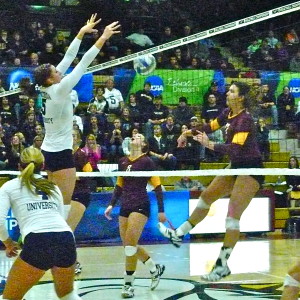
Concordia’s Riley Hanson blocked a kill attempt by UMD’s Kate Lange, and her Bulldog teammate Ashley Hinsch reflected the despair.
The road got tougher when the Bulldogs had to win an NSIC playoff opener at home to reach the league playoff semifinals and final at Concordia, where the Golden Bears are virtually unbeatable. But the Bulldogs pulled it off, winning in the semifinals and then stunning Concordia in three straight games for the league playoff title.
Riding that hot streak that counted 10 consecutive games from the final regular season game through the three sweeps of the league playoffs, and that gave UMD the home court advantage as host to the Central Regional. Once there, UMD proved it belonged by sweeping past Arkansas Tech, then Southwest Minnesota State, while Concordia got back in the groove by beating Northern State and Central Missouri.
That put the Golden Bears into the Central Region final against UMD. At stake was a slot in the eight-team NCAA D-II tournament. UMD came in 33-2, having lost only an early match to Concordia at Concordia, and a late-season match against Northern State, while Concordia’s six-straight national championship streak was under siege, but the Golden Bears brought a 31-3 record into the match, with two of the three victories inflicted by the Bulldogs.
It figured to be a match of two of the nation’s best teams, because after No. 1 ranked Tampa, UMD was No. 2 and Concordia No. 3 — in the country, let alone the league or the region.
While UMD was loaded with power-hitting Kate Lange and a very strong supporting cast, Concordia has an incredibly balanced team, with every player seeming capable of every act required of volleyball specialists. Without question, the Golden Bears would be the constant, and it was up to the Bulldogs to return to the amazing peak they had attained in their two most recent battles with Concordia.
It was clear that Concordia was at its best, trading attacks with the Bulldogs from the start, and escaping with a 25-17 first game victory. It was 16-14 late in the game when the Golden Bears came up with a series of blocks that derailed the Bulldogs, running off five straight points to go from 16-14 to 21-14, and Concordia won a vital first game.
UMD stormed back in Game 2, with Lange at her best and her teammates rallying with her for a 25-20 victory. It was a tough game, standing 13-13 until Lange led a charge for four straight points, and a commanding lead. When it was 16-13, Lange, as powerful and explosive a hitter as there is in Division II volleyball, blasted one cannon shot that struck a Concordia player crouching down in the back row trying to block, and the ricochet shot off to the right and landed in Row 4.
It appeared that if the teams played evenly, the match would come down to how well Concordia could cope with Lange’s power. In Game 3, Concordia got the early lead but Lange got free to gain ties at 13-13 and 14-14. But then Concordia’s flawless hitting balance and skill gained four straight points, and the Golden Bears held firmly for a 25-21 triumph.
That put Concordia up 2-1, and UMD would have to win Game 4 in order to avoid the end of its season and force the final to a deciding fifth game.
Concordia ruined those plans by jumping ahead 5-1. From there, the game evolved into a mighty struggle for the Bulldogs to catch up, then fall behind, then catch up again. Trailing 10-5, UMD put on a stirring rally by winning six of the next seven points, with another Lange blast gaining an 11-11 deadlock. While it was far from a one-hitter charge, Lange rose above all for kills that also provided 12-1`2, 13-13, and 14-14 ties, and the Bulldogs also evened the game at 15-all. But then it was Concordia’s turn to score six of the next seven points, with a block point making it 21-16.
Game 4 wound up 25-20 for Concordia, making it the end of a splendid 33-3 UMD season, and the end of Lange’s record-shattering career — but not before she registered 24 kills in the title match — and sending the Golden Bears to their chance at a seventh consecutive national championship with a 32-3 record.
In the array of intercollegiate sports teams at UMD, volleyball falls in there someplace behind Division I men’s hockey, Division I women’s hockey, and Division II football, and in a lot of years it might find men’s and women’s basketball, baseball and softball battling it for “second tier” prominence.
But not this season. This season, football had a fantastic run to the national tournament’s second round, and men’s hockey is stirring up new interest in its new National Collegiate Hockey Conference. But women’s volleyball is right up there with the best and most entertaining sports on campus. When the current season just ended with a three games to one loss to six-time defending NCAA Division II Concordia of St. Paul, the Bulldogs had thoroughly entertained a crowd of 1,700 — win or lose. Of course, the Bulldogs won more than they lost, dropping only one home-court match at Romano Gym, to Northern State, before falling to Concordia.
UMD coach Jim Boos congratulated the Golden Bears, and his own team. “I’m proud of how hard we played,” he said. “We just got outplayed by a team that just played better. They made only nine hitting errors all night. I’m proud of our effort, and our energy level, and we had a tremendous year, with all the records and awards, but they just weren’t making any mistakes.”
Kate Lange, who set the all-time UMD record for career kills early in the season, finished with 24 kills on 59 attempts — both nearly twice as many as any other player on either team. “It was awesome to have all those fans behind us,” said Lange. “For sure, we battled back, and if we hadn’t dug such a hold for ourselves, we probably could have done even better.”
Lange got emotional then. “I kinda felt it was our night, until it was over,” she said. “It’s crazy it’s over already…I wouldn’t have played anywhere else.”
Concordia coach Brady Starkey is legendary for his casual approach. He has his team so plugged in that his players are always upbeat, never seeming to notice, or show, any effects of pressure. “Volleyball, and sports, are supposed to be fun,” said Starkey. “The games are much easier when everybody takes a light approach and is enjoying it.
“When they beat us 3-0, it was a good match. Our girls realized that if we don’t come to play in the final, what could happen. We played very efficient and clean and it was a total team effort. We got blocks when we needed them, we covered, we scrapped, and we got through some long rallies. We did a good job of taking what we could, and we got good touches to slow them down.”
Kayla Koenecke, a senior from Delano, has now played in — and won — regional and national championships every year. She’ll be trying for her fourth while the Golden Bears will be striving for their seventh. I asked he if she could ever envision Concordia losing in this Central Regional final. “No, I can’t ever envision that,” she said. “We enjoyed every point, because four years is too short, and you never know when you might have your last game together.”
Lange capped her senior season by being named first-team All-America, and then won the Division II volleyball player of the year award.
Hibbert Flies Past SnoCross Foes
By John Gilbert
It’s understandable pro snowcross racers aren’t satisfied when they lose, but Tucker Hibbert is the top pro snowmobile racer on the planet because he is more demanding than the normal racer. “I’m not always satisfied when I win,” Hibbert said at Spirit Mountain before last weekend’s AMSOIL Championship — the season-opening race on the 9-race 2013-14 schedule.
But after a slow start, Hibbert was definitely satisfied after sweeping both Pro Open feature races Saturday and Sunday. Not that it started out smoothly. Hibbert, who has won seven Snowcross championships but failed to win either last season or the season before at Spirit Mountain, went out on the creatively challenging jumps and hills carved into the top of Spirit Mountain and promptly had a problem in the match-race dominator competition Friday night. He came back to not only win Saturday night’s feature, but he lapped the entire field in the process.
On Sunday afternoon, with a large and enthusiastic crowd in the stands and spilling out of the chalet, Hibbert’s Arctic Cat was beaten off the starting surge by Kyle Pallin’s Polaris, and after they hopped, leaped and churned up the backside and came around the top of the course, Hibbert caught up. When they came past the finish line, Hibbert took the inside line and actually made the pass on Pallin as the two flew through the air and landed at the bottom turn.
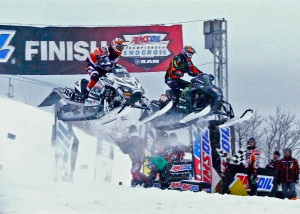
There was a difference between the first and last laps of the AMSOIL SnoCross feature at Duluth’s Spirit Mountain. On the first lap, left, Tucker Hibbert made a flying pass of early leader Kyle Palliln; on the last lap, Hibbert was alone with the checkered flag.
From there, Hibbert made no mistakes, cruising to the victory that gave him a sweep of the weekend’s two Pro Open features and capped the weekend that also saw Pro Lites, Amateur, Women, and Junior Novice classes. The top two categories are the Pro Lites, for stock 600 cc. engines, and the Pro Open for modified, highly sophisticated 600s.
In Minnesota, Arctic Cats, which are made in Thief River Falls, and Polaris, which are made in Roseau, are the homestate favorites, but Canada’s Bombardier Ski-Doo machines, and the new Yamaha racers offer more competition. Hibbert, who now lives in Pelican Rapids, MN., grew up in Thief River Falls, and, naturally, has raced Arctic Cats since he started racing semi-pro, and turned to Pro in 2001.
“We have a 600 cc. two-stroke engine displacement limit, and Arctic Cat uses Suzuki engines,” said Hibbert. “We can make modifications to the oompression ratio and exhaust, and we make a lot of mods to the chassis and suspension.”
Year-round workouts, including motocross motorcycles in the summertime, keep riders like Hibbert in shape for the pounding they take on a course such as Spirit Mountain. The series is similar to NASCAR, where the season opens with the Daytona 500 — the biggest race of the season. The troupe moves to Blackjack Resort in Bessemer, Michigan, for the second race this weekend, then takes a break until the January 3-4 weekend at Canterbury Park in Shakopee.
An estimated 30,000 fans showed up for the three-day races. Among the colorful people who make Snowcross racing such an entertaining event are people like Rob Dahlen, who helps Tucker Hibbert and his brother and crew chief Kirk Hibbert with managerial duties. “When I was growing up in Thief River Falls, I raced a Polaris,” said Dahlen. “That didn’t go over too well and I got a lot of flak for being the only one on a Polaris when everybody else in Thief River Falls was on a green Arctic Cat. I was probably the first victim of bullying.”
Then there was Jake Scott, a rookie in the Pro Open category, who came to Minnesota a couple years ago and is now making the move up from Pro Lites as a teammate of veteran Levi LaValee on a Team LaValee Polaris. “I grew up on Long Island, and started racing snowmobiles when I was 13, in Vermont,” Scott said. “I did pretty well there, so I figured I’d come out west and see what it was like. It’s totally different; these guys are animals.”
Scott said it was his first time being interviewed. When asked how old he was, he said: “I’m 19, but I’ll be 20 in 10 months.”
Doing the math, that also means he’s just two months past being 18.
Asked if he works on the engines, Scott said: “No way. I wouldn’t ride anything I built!”
When his assessment was sought, and whether his mentor, Levi LaVallee, might be the favorite, Scott said: “That’d be great, but at this point, if I had to pick a favorite, it would have to be Tucker Hibbert.”
Quick learner, this rookie.
A week later, Hibbert swept both features at Bessemer, Michigan, as well, ending calendar 2013 by tying snocross legend Blair Morgan;s career record 84 victories. Hibbert opens 2014 at Canterbury Park in Shakopee, going for No. 85.
The Cup, and rings, and valid inspiration
By John Gilbert
Last weekend was about as big as it can get for UMD athletics, with the football team winning an enormous Homecoming game, the women’s hockey team opening its season with two rousing victories over an outgunned Connecticut team, the volleyball team sweeping two more matches to defend its No. 2 national ranking, and the men’s hockey team extending the weekend to Monday night with an explosive 7-1 victory over Lakehead University.
The whole thing started, and was highlighted, by Norm Maciver’s presentation of the Stanley Cup. Maciver, who was a standout defenseman at UMD in the 1980s, is now the standout assistant general manager of the Chicago Blackhawks. Tradition has it that everybody on the winning team gets one day with the actual Stanley Cup, and Friday was Norm’s day with the sparkling silver chalice. He came home to Duluth which allowed him to visit his family and also to give Duluthians a chance to get up close and personal with the Stanley Cup.
Later he brought the Cup out to Heritage Arena where his son was practicing with Denfeld’s team, but the biggest presentation was at AMSOIL Arena. Before UMDs women faced Connecticut to open their nonconference series, Lord Stanley’s glorious cup stood at the west end of the concourse, while fans and interested spectators circled three-fourths of the entire concourse waiting for the chance to see and get photographed with the Cup.
The Cup is a wonderful spectacle on its own, with all the teams, and all their players, inscribed on ring after ring of space. Everyone knows what the Stanley Cup looks like, and everyone who earns the right to handle it can tell endless stories of weird things that have happened to the prized trophy while in the hands of individual players. But can anyone think of a trophy for professional baseball, football, basketball, or anything else, that approaches the Stanley Cup for class and elegance?
It’s the second Cup for the Hawks while Maciver has held a key position in player selection and assignment, and it’s typical of his class that he wouldn’t forget his adopted home.
Just as intriguing is the pair of rings Norm displayed, signifying the two Stanley Cup championships. Maciver put one on the ring fingers of either hand, and held them out. I kidded him that it was about as much weight-lifting as he is required to do these days to put both rings on and simply lift his hands.
Maciver stayed beyond his scheduled time with the Cup at AMSOIL, although he did finally have to take it and depart for other commitments and leave a few hundred fans in line. As he stood off to the side, talking with old friends, acquaintances and former teammates, I couldn’t help but ask Norm if he didn’t get a little weary of the long day of being such an attraction.
“No way,” he said. “How many times in anyone’s life do you get the chance to do something like this?
Typical. Norm Maciver could have put the Cup on his back deck and entertained his closest friends and family in a private day with the most impressive trophy in all of professional sports, but he never considered that. It was his time to share, and give back, the highest honor in hockey to Duluthians.
CUP RUNNETH OVER
Maybe the Stanley Cup gave special motivation to all the sports teams at Minnesota-Duluth, Maciver’s alma mater.
The women’s hockey team hammered Connecticut 7-0 on Friday and 6-1 on Saturday, amassing a 109-38 edge in shots in the two nonconference games. The Saturday victory was Shannon Miller’s 350th as the only coach of the Bulldogs. That free-scoring weekend may serve the Bulldogs well as they head for Grand Forks this weekend to face a North Dakota team that is ranked as a contender in the WCHA, while UMD is not.
On Saturday, the UMD football team broke from a rain-drenched 7-0 deficit in the second quarter to an amazing eruption of points and a 44-7 victory over a St. Cloud State team that looked like possibly the better team through the first half. Still ranked No. 11 in the nation among Division II teams, the Bulldogs will hit the road with renewed confidence in their running game and their defense and play Saturday at Minnesota State-Moorhead.
Immediately after the football game at Malosky Stadium Saturday, it was possible to go across the parking lot and inside the warmth of Romano Gym to watch the No. 2 ranked UMD volleyball team disassemble Winona State in three straight games for the Bulldogs second victory in as many nights. And then, there was time to dash down to AMSOIL Arena to catch the second UMD-Connecticut women’s hockey game.
That all-victorious weekend spilled over to Monday, when the UMD men’s hockey team opened its season with a game that went from a close encounter to a 7-1 blowout victory over Lakehead. That will pump up the Bulldogs for this weekend’s official season opener with a pair of nonconference games against Michigan Tech at AMSOIL. Tech, of course, was one of UMD’s first Division I rivals back in the 1960s, when UMD first moved up to D-I, and after such a long-standing rivalry, it’s great that the two schools can stay involved on a nonconference basis now that Tech remains in the WCHA and UMD splits for the great unknown of the National Collegiate Hockey Conference, where the Dogs were picked sixth out of eight teams.
Maybe Norm can find a way to come home every weekend to spark the Bulldogs teams. And he should bring the Cup and those rings.
Stranger from Japan proves familiar
By John Gilbert
It seems a long time ago, because it was, in the mid-1960s. I was just starting out as a sportswriter, and the University of Minnesota-Duluth was just starting to dabble in hockey at the Division I level. The Bulldogs, under coach Ralph Romano, played in the old Curling Club, and while their favorite rival was Minnesota, the big powers in college hockey were Michigan, Michigan Tech, North Dakota, and Denver.
Michigan won the NCAA hockey championship in 1964 with a collection of big, strong and talented players, and one little guy — a darting centerman named Mel Wakabayashi. In Duluth, we knew all about talented little centers, with Keith (Huffer) Christiansen directing virtually all of the meaningful offense the Bulldogs could muster. Huffer won a WCHA scoring title and became an All-American, shortly after Wakabayashi won a league scoring title and became an All-American.
It was easy to pay attention to Huffer’s play after college, because he played on the 1972 U.S. Olympic team as a naturalized citizen from Fort Frances, Ontario, and then got a chance to play for the Minnesota Fighting Saints in the World Hockey Association. It was not as easy to keep up with Mel Wakabayashi after college.
Fast forward 40-some years. Now it is 2013 and the University of Minnesota women’s hockey team opened its season with an interesting exhibition game against the National team from Japan. Now, Japan is not a threat to win any medals in men’s hockey, and seems farther removed from the comparatively fledgling women’s international hockey.
But Japan came to Duluth and acquitted itself well. Having tied St. Cloud State, and lost to the WCHA’s top two seeds — Minnesota (6-0) and Wisconsin (3-0), Japan jumped ahead of UMD when Rui Ukita scored on an unprotected rebound to open the game. UMD freshman Ashleigh Brykaliuk tied it 1-1 on a power play late in the opening period. Hanae Kuba scored for Japan at 13:33 of the second period, and it took another power play for Meghan Huertas, another UMD freshman, to score for a 2-2 tie.
Japan was quick, moved the puck better than the first-game-rusty Bulldogs, but UMD prevailed in the third period as Jamie Kenyon scored a hat trick, including an empty-net goal, and Katherine McGovern, yet another unknown UMD skater, also scored. UMD outshot Japan 43-13 for the game, but Japan’s goaltender, Azusa Nakaoku, was outstanding.
After the game, I scanned the Japan lineup in the AMSOIL Arena press box, hoping to see some name that might ignite a glimmer that I could find a brief communicator. At the bottom of the roster, it said: “Team Leader — Mel Wakabayashi.”
Could it be? I scoured the lower corridor of the arena and finally a team liaison fellow produced a short, stocky Japanese fellow, and pointed at him. I approached with some degree of caution and asked if he had ever played college hockey. “Yes,” he said. “At the University of Michigan.”
Bingo!
We had an interesting conversation, and I told him I had watched him play in the Curling Club, against UMD, and down at the old Williams Arena, against the Gophers, while writing for the college newspapers, and then for the Duluth News Tribune.
He was extremely humble, and gracious, and I had to drag his personal information out of him.
“Yes, I played against Huffer in Duluth once,” he said. “Yes, I led the league in scoring once. I played with Gordon Wilkie, Wilf Martin, and Tom Polonic at Michigan, and Bob Gray was our goaltender…”
I mentioned that Polonic, in particular, was a huge tough guy who made it to the NHL with his ruggedness. “Yes, I needed players like that,” he smiled. “We won the NCAA title in 1966. Beat Denver 6-2 in the finals.”
What about after college? The NHL didn’t give college players much of a chance. “I signed with the Red Wings after college in 1967,” he said. “They sent me to their Memphis farm team, but after a few games I got the chance to go to Japan and play in their six-team professional league.”
I insisted Walabayashi must have been the best player in Japan by a mile, and he insisted he wasn’t. But I’m pretty sure I’m right, even though he said there were a couple of good players from Northern Japan, and then his brother. Herb Wakabayashi was an All-American at Boston University.
“Herb changed to Japanese citizenship so he could play for Japan in the Sapporo Olympics,” said Mel. “I was the first foreigner to play in the Japanese league when I moved there in 1967. I played in that league until 1979, and I live in Tokyo now. I got my Japanese citizenship in 1994. You aren’t allowed to have dual citizenship in Japan, and I was a third-generation Japanese Canadian.”
After playing pro hockey in Japan for 12 years, Wakabayashi — whose name officially is Hitoshi Mel Wakabayashi — moved into player development, and rose in prominence until he now is vice president of the Japan Ice Hockey Federation. He is guiding the women’s national team as it tours and plays in preparation for the upcoming Winter Olympics in Russia.
I asked Mel where he grew up. “British Columbia,” he said. “We lived in Slocan City.”
I’ve been to British Columbia, and watched hockey games there, and I’ve heard of almost every little town in the province, since they feed a lot of players to college and pro hockey. But I’ve never heard of Slocan City. I asked him about the town, which is deep in the Canadian Rockies, quite a distance east of Kelowna, and considerably north of Trail, and Castlegar.
Without hesitation, Wakabayashi said: “It was an interment camp, during the second world war. I was born in 1943, and we lived there.”
We in North America, both the U.S. and Canada, didn’t treat Japanese immigrants very well during World War II, securing them in separated villages that a fool could mistake for low-pressure prison camps. He shrugged. “It was wartime,” he said, as though that excused such confinement.
He looked good, like he could still skate few darting moves out there on the rink. Made me wish I had called Huffer. He probably would have come down to AMSOIL to renew acquaintances, and maybe I could have coaxed the two of them to play a little 1-on-1. Huffer Christiansen and Mel Wakabayashi. They don’t make ‘em like that anymore.
ESKO’S NEW FIELD
The big dedication game was last Friday, and Esko High School opened its slick new artificial-turf football field with a rousing 28-14 victory over previously undefeated Two Harbors. The passing of Marc Carlson was virtually unstoppable, and the fired-up Eskomos ran up a 20-0 lead almost as soon as the pregame ceremonies were over.
A skydiver dropped in, and all sorts of other festivities set the proper tone, with returning past heroes of the Eskomos and a big crowd providing a big home-field advantage. The field is impressive, with the current trend of propping up the artificial blades of grass with a few million tiny black particles form shredded discarded tires. Makes for a springier step and expanded usage.
Just for good measure, it rained pretty steadily, as if to prove the turf’s merit. And the next day, instead of a muddy mess, they played a couple of soccer games on the same surface.
Wild put potential on display in Duluth
It was a win-win situation when the Minnesota Wild made what could become an annual preseason trip to Duluth. The act of bonding a team together for a couple of days provides a break from training camp and exhibition games and can serve as a positive influence before the start of the regular season. Meanwhile, it’s positive public relations to show Northern Minnesota and the Duluth area that the Wild are the state’s team, not just a neat logo on a Twin Cities operation.
It’s also a major plus for the North Shore hideaway lodging facility, and for the hockey fans who chose to attend the open, and free, Wild practice at AMSOIL Arena.
There are a lot of reasons to be enthused about the Wild this season. Not the least of those is that general manager Chuck Fletcher showed the patience and good sense not to tear apart the team for reckless trades. He made a couple of key acquisitions, and added the fine-tuning touch coach Mike Yeo needs to put together a consistently competitive franchise. The divisional realignment is another huge plus.
“We’re excited about the upcoming season,” said Fletcher. “We should have a fun division, with the Stanley Cup champs (Chicago), the St. Louis Blues, who are as good as any team in the NHL right now, and from a geographical standpoint, teams like Winnipeg, Dallas and Denver, who will become big rivals.”
That means so long to so many long-distance, midnight-finishing road trips to Calgary, Edmonton and Vancouver, as well. The resurrection of old-time North Stars rivalries with the Blackhawks, Blues and Colorado, as well as the built-in intensity of the Dallas (former North) Stars, is a huge plus, and Fletcher may be less aware that Winnipeg, while never a huge rival of the North Stars, was indeed a huge geographic rival of the old Minnesota Fighting Saints in the World Hockey Association — the days of Bobby Hull, Anders Hedberg and Ulf Nilsson on the best line in hockey.
The good-news/bad-news finish to last season was frustrating, but the facts remain that a couple of crippling injuries prevented what might have been an impressive playoff rush. Dany Heatley went out with an injury, and the timing couldn’t have been worse. The Wild were leading their division and clicking on all cylinders, and Heatley was finally looking like his old sniper self when he went down, and the Wild power play went down as well.
In the closing two weeks, newly acquired Jason Pominville was hurt in a cheapshot incident that knocked him out for the rest of the season before Wild fans could learn to appreciate how much he added to the roster. In fact, if you lined up the Wild offense, you could make the case that Zach Parise, Mikko Koivu, Heatley and Pominville were the most dangerous scorers, and to remove two of the four was simply not fair.
The ensuing drop meant the Wild had to win their final game of the season to grab onto the eighth and final playoff spot in the West, and that earned the Wild the opportunity to face the Chicago Blackhawks, who were the best team in the entire NHL. The Wild might even have made a run at an upset, but ace goaltender Niklas Backstrom suffered a badly pulled groin during warmups for the first game of the series, and he was done. Josh Harding did a great job as backup, but he, too, was hurt during a pileup after winning Game 3.
No teams that advanced to succeed in the playoffs could have done so if you remove two of their top four goal-scorers and their starting goaltender. So just retaining those key players and staying healthy might secure the Wild as a contender. At the same time, key additions like Matt Cooke, Keith Ballard, and Nino Niederreiter could be difference-makers. Add in the potential of former UMD star Justin Fontaine, who has proven he can score and play the whole game at both ends of the rink while at the Wild’s top farm club, and you have to like the balance and potential of this roster.
“We think we have good balance through four lines, and on defense,” said Fletcher, before the Wild hit the AMSOIL ice Monday morning.
“We’ve been impressed with Niederreiter’s play. He played well in the American League, and he scored well in the World Championships. He was probably a little overwhelmed when he played a little in the NHL at age 19. He’s big, at 210 pounds, and he liked to go to the net and battle with defensemen. I would say that he and Dany Heatley probably have the heaviest shots on the team.”
Niederreiter scored six goals in the World Championships for his native Switzerland, which, if your recall, was the surprise of the whole tournament, going undefeated all the way to the Gold Medal game, where it lost to a Sweden team reinforced by some players like the Sedin twins of Vancouver, after early Stanley Cup exits.
With the season getting underway for real Thursday night, against the Los Angeles Kings at Xcel Energy Center in Saint Paul, the judging of the Wild will commence immediately. It won’t hurt their fan base that they now have an enhanced and enthusiastic backing from the Duluth area — for “our” team in the NHL.
Ex-UMD coach Nielson throws scare into Gophers
By John Gilbert
The Minnesota Golden Gophers scored a couple of late touchdowns Saturday to make their 29-12 victory over Western Illinois seem comfortably secure. When it was over, after a brief amount of mingling on the turf at TCF Bank Stadium, both teams headed off toward their respective locker rooms. I had watched from the stands, and after the game I headed down toward the field to try to catch Western Illinois coach Bob Nielson before he got up the walkway.
As I made my way down the staircase to the bottom row of the stands, a Gopher fan who had hustled across in the front row nearly collided with me in his urgency to get to the railing above where the Western Illinois players were departing. I figured a Western Illinois player must be the son of a friend or something, and he was probably hurrying over to catch his attention. I was wrong.
“Hey, Western…Come back any time,” he shouted, with his voice dripping with sarcasm, at the whole Western team as they walked by. By his tone, you’d have thought the Gophers thoroughly wasted Western Illinois, and enjoyed humiliating them.
“I’ll bet you didn’t yell that when it was 12-7, in the third quarter,” I said to him, then walked away as he stopped in silence, possibly embarrassed that a witness had observed his blatant inhospitality.
It had been anything but a humiliating victory. I realize Gopher football fans are so starved for legitimate victories that they can’t resist jumping at the chance to gloat, no matter what the circumstances. But such arrogance is never attractive, even in sports, where rude outbursts from fans have replaced sportsmanship — remember sportsmanship? So I couldn’t pass up the opportunity to respond to his insult.
Downstairs, Nielson was just as smooth as he always was after his UMD teams had played, and usually won. This Gopher game, in fact, was a rare loss for Nielson, who started his chance to coach at the Division I level with two victories before bringing his team to Minneapolis. He talked about how solid Minnesota was, and how proud he was of his players for giving such a strong effort, and for throwing a genuine scare into the Gophers. He had quarterback Trent Norvell and linebacker Kevin Kintzel with him in the interview room — two of the key players who will lead the Fighting Leathernecks through the season.
For the University of Minnesota football team, Western Illinois was just another unknown “cream puff,” scheduled to bolster the Golden Gopher record in hopes of reaching a post-season bowl game. For Western Illinois, the game against the Gophers was a huge challenge, a chance to validate the Fighting Leathernecks intentions of upgrading to full-fledged Division I stature.
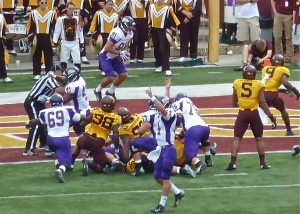
Mason Howington was open in the back of the end zone for Trent Norvell’s fourth-down TD pass and a 6-0 lead.
Minnesota won 29-12, if only the result matters. But Western Illinois caused a lot of silence among 42,000 Gopher fans at TCF Bank Stadium for most of three quarters by pretty much harnessing Minnesota from the outset. The Fighting Leathernecks took a 6-0 lead, when Norvell found the big Gopher defensive line impenetrable against the run, and crossed them up with a clutch, fourth-down touchdown pass over the middle to a wide open Mason Howington. Minnesota stormed back and went ahead 7-6 by halftime.
By halftime, starting Minnesota quarterback Phil Nelson had gone down with a bruised hamstring, and Mitch Leidner replaced him and played well, both running and passing the Gophers into the lead. Leidner’s play will force the Gophers to at least play both quarterbacks this weekend against San Jose State. At halftime, Gopher coach Jerry Kill went down with the third or fourth game-time epileptic seizure in the last three years, and he had to be carried off the field and hospitalized. We can’t know how much Western’s competitiveness, Nelson’s injury, or the threat of being the victim of a colossal upset contributed to his anxiety, but it was right out there in public view.
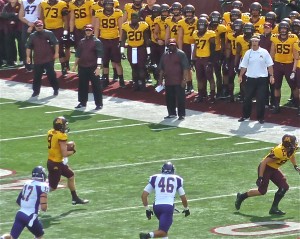
Gopher quarterback Phil Nelson ran toward the bench and coach Jerry Kill; both were gone by halftime.
Meanwhile, back to the second half. In his praise for the Gophers, Nielson said, “Their defense was so tough they pretty much took away our running game and forced us to throw the ball.”
That, I suggested, didn’t hurt Western, which had little success running the ball, while Norvell’s passing was clearly the best thing the Leathernecks had going. Despite a little coach-speak from Nielson, he acknowledged that he saw the chance to seize on Minnesota’s man-to-man coverage to spring a running back against a linebacker, and Norvell executed perfectly in the third quarter, firing a long, highlight-film pass down the middle of the field for a huge gain that put the Leathernecks in position to take the lead.
“The coaches did a great job of preparing us; all we had to do was execute,” said Norvell, who then connected for another highlight-film pass play to a leaping Lance Lenoir in the right edge of the end zone for a 12-7 lead. That one stunned the once-festive, sun-drenched Gopher fans into silence.
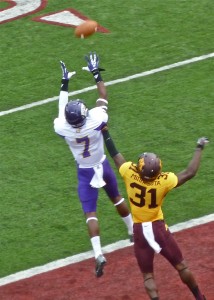
Lance Lenoir went up to catch Trent Norvell’s TD pass over Gopher defender Eric Murraty for a 12-7 lead.
Despite the final score, the chance for the upset ultimately came down to a highly unusual play. It was still 12-7 when Leidner drove the Gophers on a solid march to get inside the 5 for what seemed an inevitable touchdown to wrest the lead. But Leidner, trying a sneak, had the ball jolted out of his arm at the 3. The ball popped out and flew into the end zone. Kintzel, at linebacker, caught it and made an instaneous decision. He went for it.
Kintzel didn’t see the Gopher wide receiver, who nailed him as he came out across the goal line, dropping him at the Western 1. With no room to operate, quarterback Norvell tried his best, but could gain nothing. Western punted, but the no-room effort went only 17 yards, and the Gophers were able to slam their way right back in for the go-ahead touichdown.
Two more touchdowns in the fourth quarter put the game away. There was no second-guessing with Nielson, however. After he said he was proud his team had played such a challenging game, I had to ask a hypothetical question, as a means of underscoring how close his team was to springing the upset. “I’m always praise any player who sees the chance for a 103-yard touchdown run and goes for it,” I said. “And hindsight is always easy, but hypothetically, if he (Kintzel) drops down and takes a knee in the end zone, you would have had the ball at the 20. With a 12-7 lead, that might have won the game for you.”
Nielson calmly said: “That’s what happens in football. I have no quarrel with what Kevin did. That was an amazing turn of events down there. When you’re looking up and picking that ball off, you don’t know how deep you are in the end zone, and you have to make a quick decision. We went into the game wanting to be aggressive, and to try to win the football game.”
My question was intended to praise Kintzel, not to accuse him of any misplay.
“We knew it would be a battle,” Kintzel said. “The coaches put us in the right spot to pull this off, and I know they’re counting on me to make big plays. I thought I had an edge there but I can’t be dropping balls like that.”
Sure enough, Kinzel earlier had gone over to help a teammate on pass coverage, and when he leaped for the interception, the ball glanced off his hands and fell to the turf, with nothing but space between him and the end zone.
Still, if you’re a coach like Nielson, you want to have players who will take a chance, or two, on making a game-breaking play. In this case, Kintzel showed exactly that kind of aggressive confidence. He didn’t go all the way on either chance, and either one or both might have won the game. But surely neither cost Western Illinois the game.
Nielson praised Gopher coach Kill for resurrecting a Gopher program that was in ruins, and he said his hopes and prayers were with him for a speedy recovery from the seizure. It ruined what was otherwise a festive day at the stadium.
“What a great environment,” Nielson said. “It doesn’t matter if you’re playing before 42,000 fans or on a sandlot, it’s still the same game. But it was really a great opportunity for us to play in TCF Bank Stadium.”
Everybody enjoyed the exciting game with Goliath outlasting David. Except, maybe, the singular rude and classless Gopher fan among the 42,000 trying so desperately to insult the visitors afterward. It was just my bad luck to run into him after the game.
UMD VOLLEYBALL WORTHY OF NO. 1
It’s different to be the aggressor, chasing success if not perfection, and suddenly achieving it. UMD’s volleyball team will now demonstrate that if you do the former well enough, you then get a chance to do the latter.
The Bulldogs started the season ranked No. 4 in the nation in NCAA Division II women’s volleyball, and after a spectacular start, the Bulldogs rose to No. 1 and stand 9-0.
Last season, the Bulldogs chased No. 1 ranked Concordia all the way to the finish. They beat Concordia in one match, but fell short at playoff time. UMD had a powerful team, with several freshmen contributing, and several outstanding seniors, but it was Kate Lang rising above the net to blow powerful blasts past opposing blockers that was UMD’s chief threat.
With those seniors gone, coach Jim Boos has Lang, those year-older freshmen from last year, and a perfect blend to make a serious run at national honors.
“Certainly, being voted No. 1 might play an unforseen part in our players’ heads,” said Boos. “Now we’re at the precipice, after being No. 4 to start. But even at No. 4, we had a target on our backs. Ultimately that’s not going to change. I never put much stock in where we’re rated, but being No. 1 is nice, because it means we’ve accomplished something.”
Lang, from Hibbing, remains the dominant threat and the focal point of opposing blockers, and when the circumstances require it, she can be unstoppable. While the Bulldogs opened with two tournaments on the road, Lang recorded 33 kills in one match, then came back with only 12 the next day.
“The thing was, we had two or three players with 9 kills,” Boos said. “We’re much more balanced this year. We’ve matured a lot, and our setter, Ashley Hinch, who was honorable mention All-America as a freshman last year, has a much better idea of how to distribute the ball.
“Lang, of course, is not real vocal but she leads by doing. She plays the entire game — attacking, passing, blocking, passing, with her skill and experience. We rely on her in crunch moments.”
Boos came to UMD in 2002 after being an assistant coach at North Dakota State, a power in the North Central Conference. It was a good move, because UMD was moving into the NCC. It never gets routine, or easy, to run a major program, but Boos has found a comfortable way of operating.
“A culture has been created here,” he said, leaving out the fact that he created his own culture. “The circle repeats itself now. Kids come in and learn from others. It helps that I’ve had Kristen May as my assistant for 10 years, too. That helps me spend less time on little details. Everybody who we recruit knows they have to stay on their toes and keep improving, and that no matter how good they were in high school, it might take a year or two to crack the lineup.”
This season, the Bulldogs are so potent that there wasn’t a huge need for any freshmen to come in and be impact players.
“With three freshmen and two sophomores playing so well last year, among 12 returning players, we had no immediate need for freshmen to play big roles this year,” said Boos. “We have four freshmen on the team, but only one got into a game so far.”
UMD is riding an interesting crest right now, with football maintaining excellence — and facing a huge game against Minnesota State-Mankato Saturday at Malosky Stadium — and Division I men’s and women’s hockey continuing as strong contenders for league and national honors. But inside Romano Gym, the UMD volleyball team is forcing students and fans to take notice.
PONDER THE QUESTION
At last, Christian Ponder played like a competent NFL quarterback last Sunday. He must have, because all the critics in the Twin Cities were jumping up to blame both the Vikings offensive coordinator and defensive coordinator for the fact that the Vikings lost 31-30 in Chicago.
Strange, but when the same offensive coordinator called the shots as Ponder led the team into position for a late touchdown that would have clinched what was then a 3-point game, and when he called for Ponder to throw a pass into the end zone on second down, there was no accompanying order that Ponder miss his target that time. But when the third-down play was Adrian Peterson up the middle for no gain, the Vikings had to settle for a field goal and a 6-point lead, it was all finger-pointing time.
The lead didn’t last because Jay Cutler brought the Bears back for a late touchdown pass, which set the same critics off to blame the defensive coordinator. Only the players got it right, saying profoundly that when the coordinator calls the play, it’s still up to them to execute and make it effective.
In Ponder’s case, my only curious thought is whether or not he is allowed to call audibles when he comes up to the line and sees the planned play heading for trouble and maybe the defense is giving something else. Sure, I would have liked to see Peterson run wide with a pitchout, instead of trying to crack a rugged Bear defensive line.
But consider in both cases, had either Ponder’s second-down pass or Peterson’s third-down plunge been successful, the same critics would have raved about how great they were, and the offensive and defensive coordinators would have remained nameless.
Incidentally, San Diego didn’t play fair, keeping the ball impressively away from the Philadelphia Eagles and beating coach Chip Kelly’s hurry-up offense. Interestingly, while watching Denver and the New York Giants in the Manning on Manning duel, Denver dominated and won. Payton Manning called no-huddle plays and took immediate snaps all game in his own personal version of the hurry-up style.
How many times have you watched a defensive struggle football game suddenly flare to life in the closing minutes because the quarterback and offense switched to a no-huddle, hurry-up offense. It almost always works better than what had been a wearisome slowpoke offense until then. I’ve always wondered why teams in the NFL didn’t try more hurry-up, 2-minute drill game plans. Chip Kelly proved it can work, now we’ll have to watch to see how many teams give it a try.


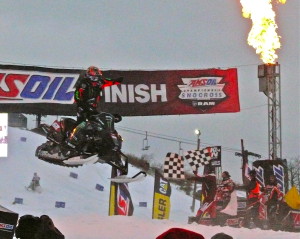
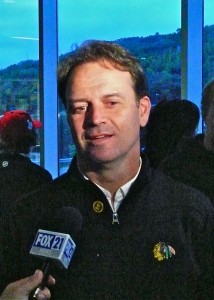
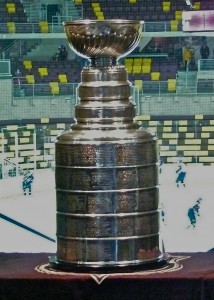
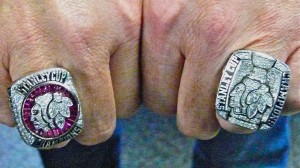

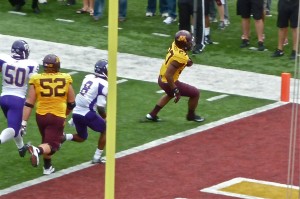
 John Gilbert is a lifetime Minnesotan and career journalist, specializing in cars and sports during and since spending 30 years at the Minneapolis Tribune, now the Star Tribune. More recently, he has continued translating the high-tech world of autos and sharing his passionate insights as a freelance writer/photographer/broadcaster. A member of the prestigious North American Car and Truck of the Year jury since 1993. John can be heard Monday-Friday from 9-11am on 610 KDAL(www.kdal610.com) on the "John Gilbert Show," and writes a column in the Duluth Reader.
John Gilbert is a lifetime Minnesotan and career journalist, specializing in cars and sports during and since spending 30 years at the Minneapolis Tribune, now the Star Tribune. More recently, he has continued translating the high-tech world of autos and sharing his passionate insights as a freelance writer/photographer/broadcaster. A member of the prestigious North American Car and Truck of the Year jury since 1993. John can be heard Monday-Friday from 9-11am on 610 KDAL(www.kdal610.com) on the "John Gilbert Show," and writes a column in the Duluth Reader.